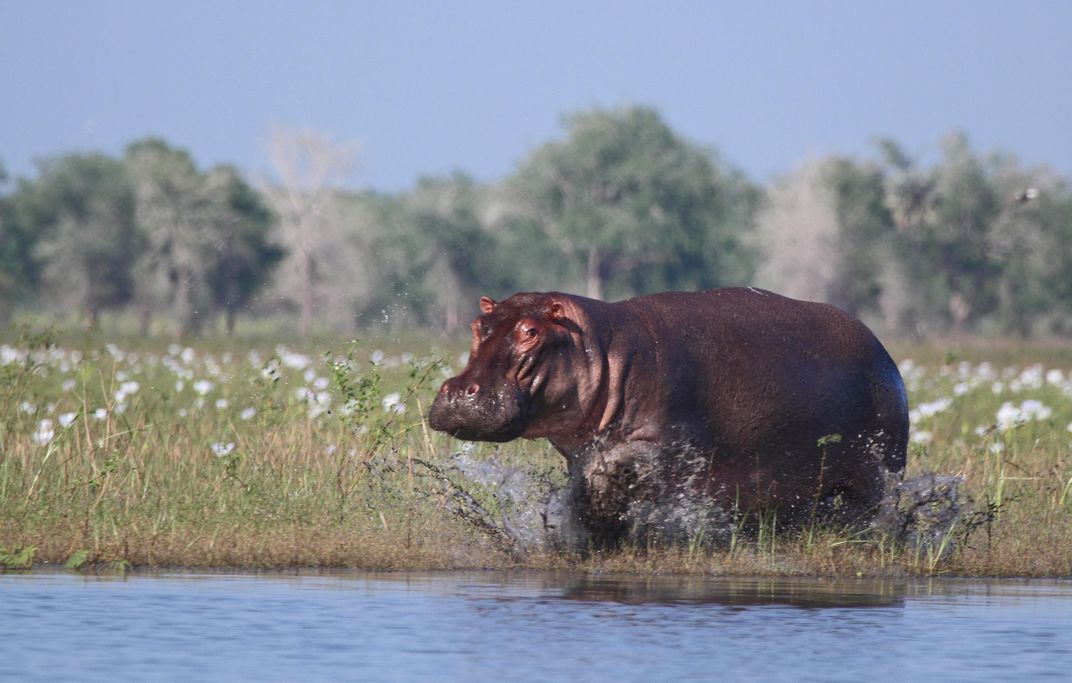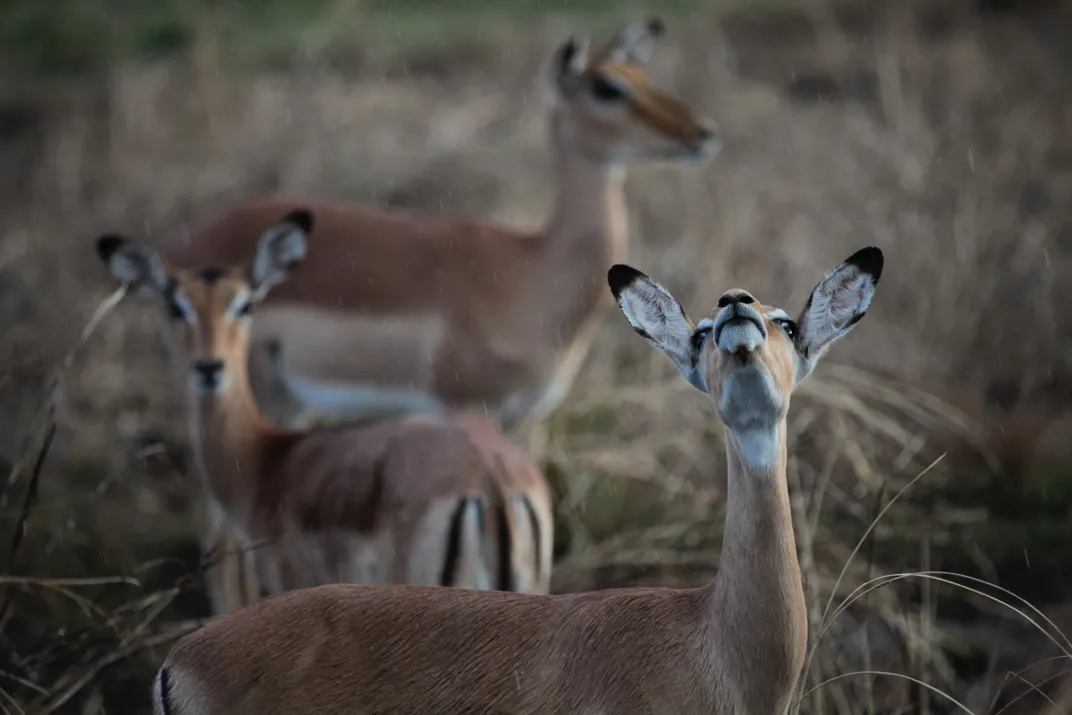The Animal Cost of War
Even low-level human conflict can drive dramatic wildlife declines
/https://tf-cmsv2-smithsonianmag-media.s3.amazonaws.com/filer/03/ae/03ae4c72-cb1e-44db-98d7-5670e264ad9a/hpj01n.jpg)
In 1977, two short years after Mozambique won its independence from Portugal, the country entered a brutal civil war. Fifteen years of bloody battle later, around one million lay dead, with millions more injured or displaced. But humans weren't the only victims of this conflict.
Much of the fighting took place in the wilds of Mozambique's Gorongosa National Park, a 1,570-square mile area rife with non-human life. During wartime, soldiers turned their guns on the animals to secure food or ivory to trade for weapons. By the time the peace treaty was signed in 1992, the populations of many of Gorongosa's large animals had been devastated—slashed by 90 percent or more.
Unfortunately, Mozambique isn’t unique. In the last half-century, more than 80 percent of major conflicts raged within hotspots of biodiversity, claiming animal lives along with human. Yet nobody has quantified the impact of these deadly affairs on wildlife, until now.
A new study published in the journal Nature sifts through troves of data going back to 1946 to put numbers on the effects of human conflict on large mammal populations throughout Africa. The results suggest that, of all the factors studied, repeated armed conflict has the biggest impact on wildlife—and even low-level conflict can cause profound declines in large herbivore populations. But there is a glimmer of hope: While most populations included in the analysis declined, few entirely collapsed, suggesting that in many locations wildlife can return once humans set down their arms.
When it comes to conservation, not all conflicts are created equal. In some cases, the isolating effects of war can have a surprisingly protective effect on landscapes. A common example is the staggering diversity of plants and animals currently thriving in the demilitarized zone separating North and South Korea. Similarly, marine life is flourishing in the thriving coral reefs along Somali pirate routes off the coast of Yemen, Djibouti and Somaliland, where the threat of plundering keeps fishermen and other locals away.
This wasn't the case in Mozambique, where the magnitude of wildlife destruction was staggering; in some ways, it’s still being felt today. The authors of the new study, Robert Pringle, an ecologist at Princeton University, and Josh Daskin, conservation ecologist at Yale University, saw this wartime destruction firsthand during a visit to the park in 2012. It got them thinking: "How typical is the Gorongosa story?" queries Pringle. "Is it frequently that populations are nearly wiped out—or could the effects in some cases even be positive?”
This question wouldn’t be easy to answer, given the scarcity of data from regions of conflict. Daskin began by scouring every document about regional wildlife he could find—NGO management reports, peer-reviewed articles, white papers, unpublished reports, foreign language reports and more. He cast his net wide to "squeeze all the data he possibly could for analysis," says Pringle, who was Daskin's PhD advisor at the time. The researchers focused on large plant-eaters—elephants, hippos, kudu—as information on small animals in conflict zones is hard to come by. But Pringle notes that, "technology and biology is marching rapidly forward," meaning tracking tinier creatures will become increasingly easier.
From this analysis, Daskin teased out around 4,000 counts of wildlife populations in conflict zones between the years of 1946 to 2010. The duo filtered these numbers to account for differences in how creatures were counted and to limit their data to only the highest of qualities. The filtering left 253 populations of large herbivores, which had comparable data for at least two timepoints. The researchers paired this data with info about historical conflicts gleaned from the Uppsala Conflict Data Program and the Peace Research Institute Oslo to examine trends in animal population changes and periods of conflict.
Next, they had to figure out what else could be impacting wildlife populations. As Pringle puts it, with any analysis this large, "there's a risk that if you just grab a variable like conflict frequency and correlate it with something like wildlife population trends, you might get a significant correlation even in the absence of a significant mechanistic link." In other words: correlation doesn't prove causation. There might be other factors at play.

To test the strength of the link between repeated conflict and wildlife populations, the duo also tested the relationship between wildlife numbers and nine other factors that could affect long-term animal well-being, including body mass, protected area size and urbanization. Overall, conflict had a consistently negative impact on creature populations. But it was the greater frequency of the conflict, not the intensity or loss of human lives, that predicted the intensity of animal decline.
"This field is one where you can find ... theoretical papers, citing theoretical papers ad nauseum, so it's very refreshing to see someone put some numbers on something," says Thor Hanson, a conservation biologist whose researches wildlife in conflict zones and was not involved in the study. He adds that the method of quantifying and analyzing the impacts is "new and important for this field."
Surprisingly to the researchers, their results showed that wildlife suffered whether conflict was raging or simmering; conflict intensity wasn’t a strong factor in predicting the intensity of wildlife decline. Daskin speculates that this could reflect the dramatic impact that social and political disruption can have on wildlife: For instance, the movement of displaced people into protected areas or the reduction of funding and staff for conservation organizations strongly tax wildlife.
Hanson agrees with the interpretation. "That's something that is not unexpected," he adds. But until this latest study, it's been challenging to "do more than sort of pontificate about [it]," he says.
Daskin has witnessed how even low-level conflict can immediately direct resources away from a region. In 2013, during his first field season studying the lingering ecosystem impacts of the civil war in Gorongosa, he returned to his camp one evening to an unusual energy. "People were sort of buzzing around like I hadn't seen before," he says.
One of the journalists staying in the park told him that old tensions had started to boil and foreigners had to leave the province. All night park rangers patrolled the campgrounds, where Daskin and others were sleeping. But the next morning, thanks to organizing by American philanthropist Greg Carr, a recovery plane picked up about a dozen people—including Daskin, a couple visitors and park employees—who were stranded at the park.
The experience showed how small clashes can quickly draw attention away from research and conservation. "It takes very little conflict for people and institutions to view these conflict zones as quite different places," he says. Case in point: Daskin was, he believes, the first PhD student to conduct research in the park since violence had largely subsided two decades before.
While the violence threshold for causing population declines was fairly low, few regions included in the study had a total collapse of species, even in regions with frequent outbreaks of violence. That means there's hope for war-impacted wildlife yet. “It should be possible to rehabilitate sites and wildlife populations in a lot of different places," says Pringle—just as Mozambique has done in the now-thriving Gorongosa.

Two decades later, the park has become something of a symbol for peaceful recovery. Many species have started to bounce back; lions, for instance, numbered in the single digits by the end of the war, while a recent survey of just 20 percent of the park turned up over 65 of the big cats. The park is considered neutral ground in Mozambique: Combatants from both sides of the conflict have come together to help in restoration efforts, with some still working there as rangers.
Similar joint efforts can be seen along a border region between Israel and Jordan, Hanson says. In the early 2000s, just a few years after signing a peace treaty, tensions still remained. But farmers on both sides found common ground in fostering a burgeoning population of the natural pest-eating barn owls, which had previously been in decline.
These kinds of anecdotes bring up an important question, says Hanson. "How can you use the cooperative management of those resources to bridge traditional lines of conflict, and can you in fact use environmental resources as a way to build peace?"
By filling in these gaps in knowledge, researchers hope to help prepare for outbreaks of violence and quicken the recovery of wildlife in the aftermath—arming themselves not with guns, but with data.
/https://tf-cmsv2-smithsonianmag-media.s3.amazonaws.com/accounts/headshot/Wei-Haas_Maya_Headshot-v2.png)
/https://tf-cmsv2-smithsonianmag-media.s3.amazonaws.com/accounts/headshot/Wei-Haas_Maya_Headshot-v2.png)